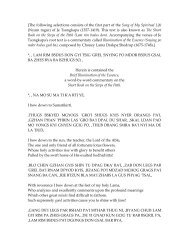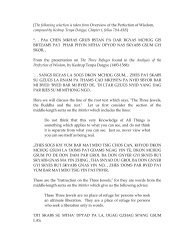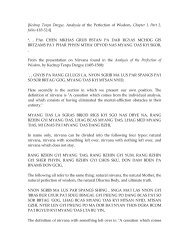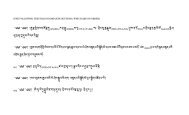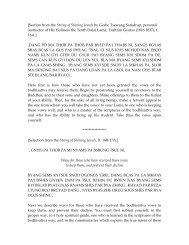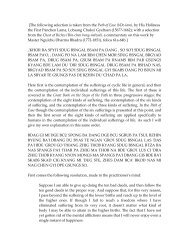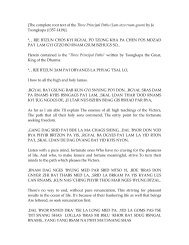[The Key that Unlocks the Door to the Noble Path (Lam bzang sgo ...
[The Key that Unlocks the Door to the Noble Path (Lam bzang sgo ...
[The Key that Unlocks the Door to the Noble Path (Lam bzang sgo ...
You also want an ePaper? Increase the reach of your titles
YUMPU automatically turns print PDFs into web optimized ePapers that Google loves.
[28.] <strong>the</strong> Brahmin's son Tsanakya: In his classic work on <strong>the</strong> Steps <strong>to</strong> Buddhahood,<br />
Pabongka Rinpoche explains <strong>that</strong> Tsanakya was able <strong>to</strong> master <strong>the</strong> difficult secret<br />
practice of <strong>the</strong> Lord of Death, but fell <strong>to</strong> <strong>the</strong> lowest hell because he used his<br />
knowledge <strong>to</strong> harm o<strong>the</strong>r beings (f. 225b, entry 47).<br />
[29.] master medita<strong>to</strong>r of Lo Diamond: <strong>The</strong> Rinpoche's Liberation in Our Hands again<br />
explains (f. 291b, entry 47). <strong>The</strong> practitioner under<strong>to</strong>ok one of <strong>the</strong> most powerful<br />
practices of <strong>the</strong> secret teachings, but due <strong>to</strong> his less than perfect motivation was<br />
able <strong>to</strong> achieve only a lower result. Lord Atisha notes here <strong>that</strong> such practitioners<br />
had even dropped <strong>to</strong> <strong>the</strong> hells.<br />
[30.] giving, morality, etc.: <strong>The</strong> first five of <strong>the</strong> six Buddhist perfections. <strong>The</strong> last is<br />
<strong>the</strong> perfection of wisdom.<br />
[31.] Suppose you fail... Quotation from Lord Tsongkapa's report <strong>to</strong> his teacher and<br />
disciple, <strong>the</strong> venerable Rendawa, on teachings received from Gentle Voice<br />
himself (ff. 2b-3a, entry 62).<br />
[32.] body of form and dharma body: <strong>The</strong> physical form of a Buddha and his mind<br />
(along with this mind's ultimate nature) are called <strong>the</strong> "form body" and "dharma<br />
body," respectively.<br />
[33.] two obstacles: See note 10.<br />
[34.] two types of desire <strong>to</strong> reach Buddhahood: See note 136.<br />
[35.] Suppose you try... Quotation from Lord Tsongkapa's opus magnum (f. 156b,<br />
entry 61).<br />
[36.] Everybody's got some mystic being... Original source of quotation not found; it<br />
appears also in Pabongka Rinpoche's Liberation in Our Hands (f. 294a, entry 47).<br />
<strong>The</strong> Seers of <strong>the</strong> Word were an eminent group of early Buddhist masters in Tibet<br />
whose lineage descended from Lord Atisha and his principal disciple, Lord<br />
Drom Tonpa. <strong>The</strong> school's name in Tibetan, "Kadampa," is explained as meaning<br />
<strong>that</strong> <strong>the</strong>y were able <strong>to</strong> see <strong>the</strong> Word of <strong>the</strong> Buddha (ka) as personal instruction<br />
(dam) <strong>that</strong> applied immediately <strong>to</strong> <strong>the</strong>ir own practice.<br />
[37.] I used <strong>the</strong> "<strong>Lam</strong>p on <strong>the</strong> <strong>Path</strong>": <strong>The</strong> full context of this quotation appears in<br />
Pabongka Rinpoche's Liberation in Our Hands (f. 37b, entry 47); it reveals much of<br />
<strong>the</strong> sources of our text and restates its comprehensive nature. Lord Tsongkapa



